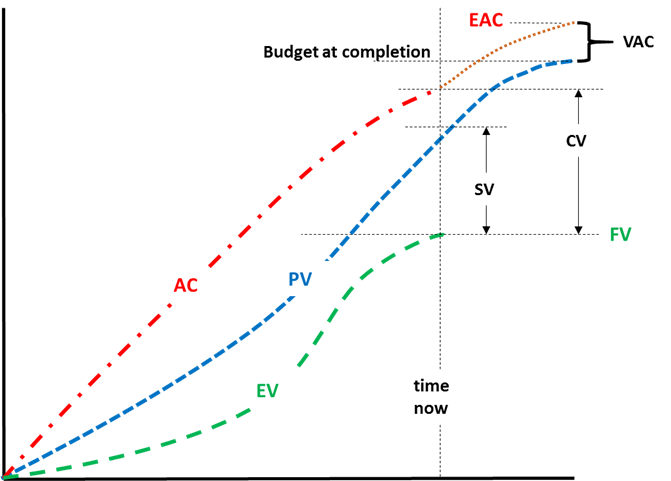Processing...
`Variance_"PERT" = "SD" _"PERT" ^2`
Enter a value for all fields
The PERT Estimated Variance equation computes the variance of some project goal estimated by the PERT method based on the PERT estimated standard deviation (SD).
INSTRUCTIONS: Enter the following:
- (SD) PERT estimated standard deviation
PERT Estimated Variance: The calculator returns the estimated variance.
PERT (Program Evaluation and Review Technique) Calculators
- Estimated Average is an estimated average for a set of estimated data.
- Estimated Variance equation computes the variance of some project goal estimated by the PERT method.
- Estimated Standard Deviation computes an estimated standard deviation based on optimistic and pessimistic estimates.
- Mean (Average) of a set of comma separated values.
- Observational Statistics for a set of comma separated values.
The Math / Science
This estimation technique supports the Program Management assessment of project goals as defined in the Earned Value Management approach. This technique is often used for estimating a value for the duration of a project and resources.
This estimated Variance of an activity is the square of the PERT Estimated Standard Deviation. [from the PMBoK Guide 5th edition, Glossary]
Earned Value Management (EVM) Calculators
- Planned Value is "The Authorized budget assigned to scheduled work." [from PMBoK Guide 5th edition, Glossary]. Planned Value is also referred to as the Budgeted Cost of Work Scheduled (BCWS).

- Cost Performance Index is a measure of the efficiency of expenses expended on a project.
- Estimated At Completion (v1) is the project management metric, the Estimate at Completion (EAC).
- To Complete Performance Index(v1) is: "A measure of the cost performance that is required to be achieved with the remaining resources in order to meet a specified management goal, expressed as the ratio of the cost to finish the outstanding work to the remaining budget.” [from the PMBoK Guide 5th edition, Glossary]
- Actual Cost computes the real total cost incurred for the work performed on an activity during a specified period.
- Schedule Performance Index is: "A measure of schedule performance expressed as the ratio of earned value and planned value.” [from the PMBoK Guide 5th edition, Glossary]
- Estimate At Completion (v2) is: "The expected total cost of completing all work expressed as the sum of the actual cost to date and the estimate to complete.” [from the PMBoK Guide 5th edition, Glossary]
- To Complete Performance Index (v2) is "A measure of the cost performance that is required to be achieved with the remaining resources in order to meet a specified management goal, expressed as the ratio of the cost to finish the outstanding work to the remaining budget.” [from the PMBoK Guide 5th edition, Glossary]
- Estimate to Complete computes the expected cost to accomplish all the remaining project work.
- Budget At Completion computes the sum of all budgets established for the work to be performed. This equation supports the Program Management assessment of project fiscal status using the Earned Value Management approach, which includes this calculation of the Budget at Completion.
- Variance at Completion computes the projected amount of budget deficit or surplus in project management assessment.
- Expected Monetary Value is: "A statistical technique that calculates the average outcome when the future includes scenarios that may or may not happen. A common use of this technique is within decision tree analysis.” [from the PMBoK Guide 5th edition, Glossary].
- Earned Value is used to measure the work performed expressed in terms of the authorized budget for that work. [from the PMBoK Guide 5th edition, Glossary]. It is also know as the Budgeted Cost of Work Performed (BCWP).
- Cost Variance computes the difference between earned value(EV) and actual cost (AC). A positive CV is indicative of an under budget while a negative CV is indicative of an over budget.
- Schedule Variance is: "A measure of schedule performance expressed as the difference between the earned value and the planned value.” [from the PMBoK Guide 5th edition, Glossary]
- Present Value computes the present value of money planned or estimated in the future that has been discounted to reflect its current value as if it existed today.
PERT - Program Evaluation and Review Technique
- Estimated Average is an estimated average for a set of estimated data.
- Estimated Variance equation computes the variance of some project goal estimated by the PERT method.
- Estimated Standard Deviation computes an estimated standard deviation based on optimistic and pessimistic estimates.
Schedule Float
- Float Start equation computes the slack time available at the beginning of a project schedule.
- Float End equation computes the slack time available at the end of a project schedule.
